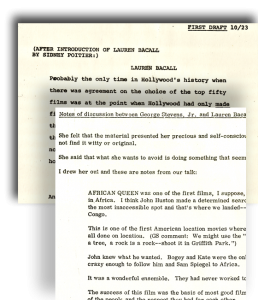
Lauren Bacall, a legend (though she despised the word) and icon of Hollywood’s golden era who taught the world how to whistle, died in New York on Tuesday.
Born Betty Joan Perske to working-class immigrants in Brooklyn, her parents divorced when she was six years old. Her mother, Natlie Perske (maiden name, Weinstein-Bacal) moved to Manhattan and young Betty Joan would go on to usher theaters on Broadway and model dresses on Seventh Avenue before her enigmatic beauty drew inquiries from Hollywood. She left for the West Coast in 1942, reemerging as Lauren Bacall (“Lauren” at the behest of producer and director Howard Hawks, the additional “L” to assist in pronunciation), catching the silver screens aflame with a mystique and unmistakable, smoldering vocal delivery.
“Betty” to long-time friends and family, but always “Baby” to “Bogie,” she sometimes bristled at the attempts of others to define her in the context of that other iconic actor, her screen foil, and her husband (until his death in 1957), Humphrey Bogart. “Being a widow,” she once told an interviewer, “is not a profession.” Bacall and Bogart sparked on and off screen in To Have and Have Not (1944), married in 1945, and would go on to star opposite one another in The Big Sleep (1946), Dark Passage (1947), and Key Largo (1948).

detail from Larry McMurtry’s notes, working with Lauren Bacall and George Stevens, Jr., from the Larry McMurtry Papers
Others will offer up more appropriate insights into the artistry and legacy of Bacall. Today, however, while obituaries abound generously peppered with the name “Bogart,” as she’d once predicted and lamented long before her passing, an interesting item from the Larry McMurtry Papers provides even more context to the Bacall-Bogart dynamic. In 1977 McMurtry worked with Bacall and George Stevens, Jr. as part of “The Stars Salute America’s Greatest Movies,” honoring the best 500 films to date. Bacall was to introduce The African Queen (1951, John Huston), starring her late husband.
McMurtry quotes Bacall on her recollections of the filming of African Queen and Bogart’s co-star, Katharine Hepburn: “John knew what he wanted. Bogey and Kate were the only two stars crazy enough to follow him and [producer] Sam Spiegel to Africa… It was the beginning of my friendship with Katie–an important part of my life and it still is.” Twenty years after Bogart’s death, however, it was clear he still served as a foil. Reflecting on their conversation, McMurtry writes, “In terms of the introduction, she would like it to be clear that she has a reputation of her own–that she is not simply Bogey’s widow. Obviously, it will be clear in her presentation that it is not purely coincidental that she is doing the introduction to AFRICAN QUEEN which starred Bogey.”
She must have known, however, that her legacy remains quite her own. Honored throughout her life by a list that includes the Screen Actors Guild, the Tony Awards, and the Golden Globes, she also received a National Book Award for her autobiography By Myself (1978). While she does recount those famous loves lost (Frank Sinatra once reportedly proposed to Bacall), she also recounts her rise as a starlet in a very particular heyday for Hollywood, including this interesting tidbit on how she went about acquiring her signature sound at the direction of Hawks:
He wanted me to drive into the hills, find some quiet spot, and read aloud. He felt it most important to keep the voice in a low register. Mine started off low, but what Howard didn’t like and explained to me was, “If you notice, Betty, when a woman gets excited or emotional she tends to raise her voice. Now, there is nothing more unattractive than screeching. I want you to train your voice in such a way that even if you have a scene like that your voice will remain low.” I found a spot on Mulholland Drive and proceeded to read The Robe aloud, keeping my voice lower and louder than normal. If anyone had ever passed by, they would have found me a candidate for the asylum. Who sat on mountaintops in cars reading books aloud to the canyons?
The Larry McMurtry Papers are available for study, along with twenty-one other Contemporary Literature collections, in the University of Houston Special Collections Reading Room.